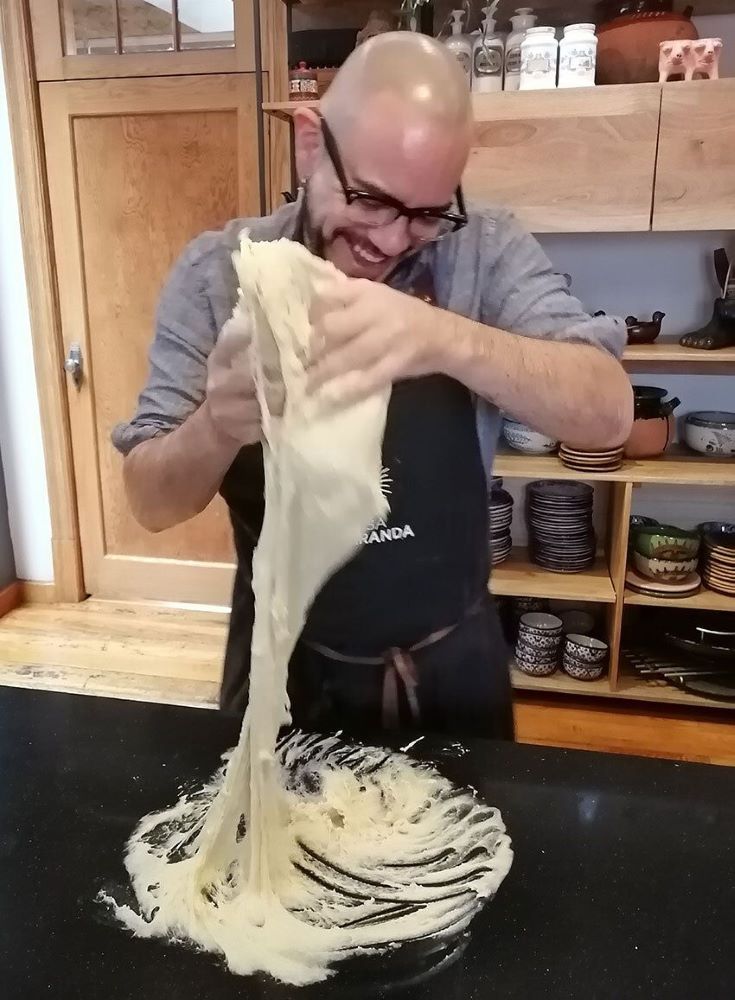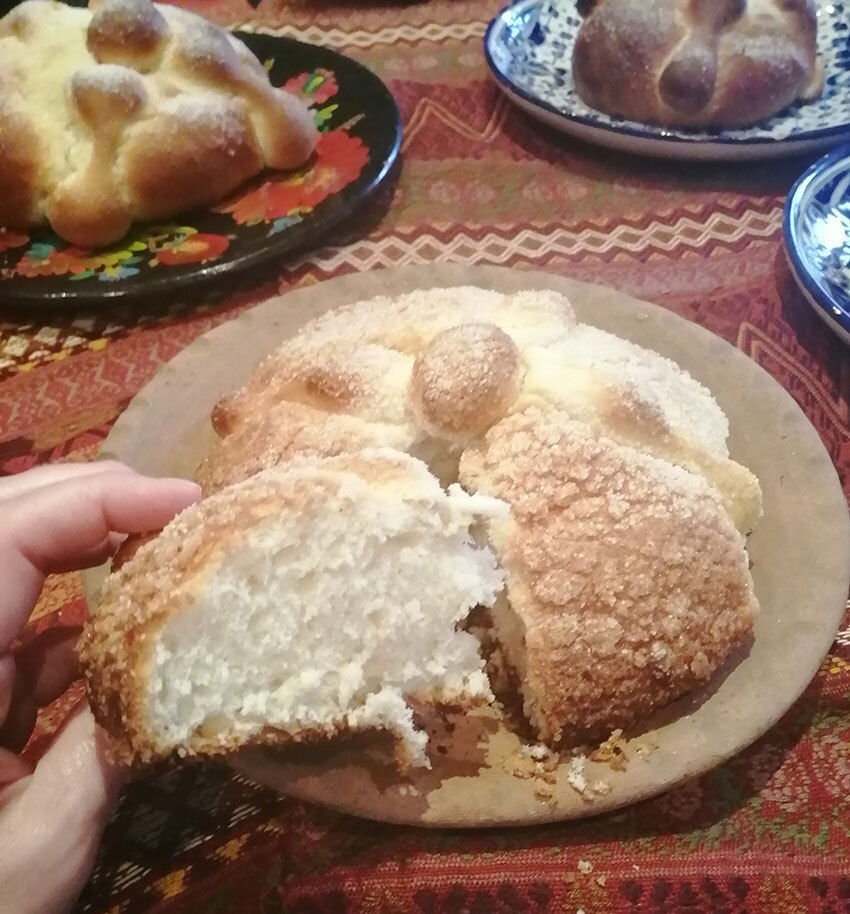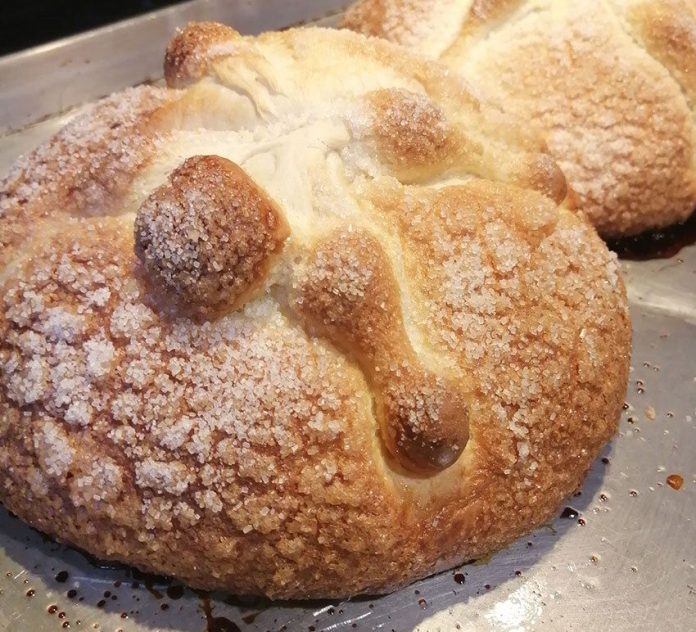Jorge Fitz’s aunt used to tell him and his cousins to be quiet around the pan de muerto dough so as not to stress it out.
“She really meant not to stress her out,” he laughs about his Tía Jose. “She would take the bowl of masa [dough] and put it in the warmest corner of the kitchen and actually wrap it in blankets like a person. No one was allowed in or out so as not to create a draft.”
This is what Jorge remembers about Day of the Dead as a child, the smells and sounds of his aunt and grandmother making pan de muerto. They would spend hours kneading the dough by hand in his grandmother’s kitchen, perfecting the final product for both the living and the dead.
It’s a commitment, this bread. When I asked Jorge and his partner Alberto (Beto) Estúa, my friends and neighbors in La Roma — who happen to own the Casa Jaracanda cooking school — to teach me how to make pan de muerto, there was a definite pause before they responded.
“We had decided we weren’t going to make it this year,” Beto says sheepishly, “just buy some instead, it’s so much simpler. But then, when Jorge said you wanted to make some, we thought, yes, of course we should make it.”

It took us seven hours of dedicated baking to create this, the most iconic food of Day of the Dead. However, when the finished product sailed out of the oven — delicately airy in the center, a crust of sugar crowning its surface — we all agreed that there is nothing like homemade, and we were glad we decided to take the time.
Pan de muerto, a sweet yeast bread covered in either sugar or sesame seeds, is a fundamental part of Day of the Dead and the elaborate altars of the holiday created to pay homage to the loved ones who have passed. Candles, favorite foods, photos of loved ones, and lots and lots of flowers are all necessary elements as well. A pinch of salt for purification and a glass of water or alcohol is also needed: coming back from the dead is thirsty work.
This Day of the Dead, which may look different for tourists without its parades and massive cemetery displays, will likely be the same for Mexicans, who have always known the holiday as an intimate celebration of their loved ones.
“I learned about Day of the Dead when I had someone to mourn for, you know? Then it became really relevant,” Jorge says. “As a kid all you want to do is Halloween and trick or treating, but Day of the Dead is more of a contemplation. It’s very intimate and sad, but with joy … you know … that very Mexican feeling, no?”
“It helps with the mourning,” says Beto. “Every year I cry over the altar, putting my grandmothers there, and of course my parents, and there’s this beautiful feeling. You put things on the altar that they loved, and maybe you say to your brothers and sisters, ‘Remember how Dad liked that?’ and you tell stories. It’s very cathartic.”
I remember the first ofrenda, or altar, that I made. My uncle had suffered a massive heartache the year before. My father, still grieving, struggled to hold back the tears when we Skyped, and I showed him Uncle Tink’s photo, surrounded by fry bread – a special treat from their childhood.
The photo was also accompanied by beer, a shot of tequila, a few cigarettes, and an old work shirt he had given me with his name embroidered on a patch – “Tinker.” I sat with his photo and the cempasúchil (marigold) flowers all night, hoping I might catch a glimpse of the uncle I loved but had had so little time to get to know.
Each year since then, my altar has grown; this year is no exception. Pandemic times have meant a lot of us have another photo to add, another loss to grieve. This year’s altar for me will include another uncle, an aunt, and a former teacher and friend of the family, all gone since the beginning of the year.
“This year is going to be different, for sure,” says Jorge, “and difficult. We have some fresh ones to put on that altar … but there are so many things to be thankful for. It is that mix of thankfulness, joy and mourning that makes it special.”

“Remember the old-school neighborhood bakeries?” says Beto. Their picture windows would be colorfully painted, announcing the sale of pan de muerto and the start of the holiday season. As a child, Jorge would steal the bread “bones” off the top of the pan de muerto buns, and his grandmother would be forced to buy all the bread he had damaged. She didn’t love that, Jorge says, laughing.
Beto’s family would take flowers to the gravestone of his grandfather, who died before Beto had a chance to know him. Both men can remember carrying candles dripping with wax to family cemeteries.
In the kitchen, Beto explains to me that the bread’s criss-cross “bones” are meant to be the skeletal hand of the deceased as they claim one of these delicious confections for themselves from beyond the grave. Altars always include favorite dishes and favorite liquors and tobacco of those passed, in the hope that their spirit will return to commune with the living for just one night.
“Even making the food beforehand, you have them right there,” says Jorge. “It’s like you’re stirring together.”
While I can’t relate exactly to their childhood nostalgia for Day of the Dead, as I stand in the kitchen measuring ingredients and listening to the rhythmic smack of Jorge kneading the dough, the sensation of home and comfort is unmistakable. It reminds me of holidays with my own family, gathered around the countertop, stealing scraps from whoever was cooking.
The pan de muerto recipe we use is an amalgamation – combined elements of Tía Jose’s recipe, now over 100 years old, a classic version from Josefina Velazquez de Leon’s Seleciones Culinarias, and a simpler, more classic version Beto learned from chef Yuri de Gortari, whose Escuela de Gastronomía Mexicana is infamous throughout Mexico City.
Beto started the sponge this morning before I arrived – a combination of flour, milk, yeast and a little sugar. The remnants of a yeast bubble explosion are sticky along the sides of the dish. We cheat (just a little), mixing the first part of the dough in a bread mixer, but the guys have done it many times by hand, so they have street cred.
I myself spent last year mixing kilos upon kilos of dough with the García family at the Jamaica Market where they set up a stand each year and sell pan de muerto in bulk. It’s not for the faint of heart, and you have to understand the exact texture of the ready dough that only comes from years of experience.
Once the perfect consistency is attained, it’s time to let the dough rest until doubled, and, of course, it’s time for lunch.
“You don’t have to feed me,” I insist.
“Of course we do,” Beto smiles graciously, radiating the Mexican hospitality that I have come to love so much.
Our stomachs full and our dough doubled, we roll it into balls and add its dough “bones” atop the mounds to let it double again. The bone making takes its own special skill as you roll three fingers across a length of dough, trying not to make it either too thick or thin. A discussion ensues – the banter of two people who have made this bread dozens of times yet are still perfecting the recipe batch by batch.
There are two methods to add the sugar topping: Jorge opts for the Tía Jose’s version that involves egg wash and the piling on of sugar to create a crunchy crust. Beto wants to baste the pan de muerto with butter after it has come out of the oven and sprinkle sugar on top. We decided to do both.
Twenty-five minutes and one Pacífico beer later, the bread is coming out of the oven in golden-brown perfection. Jorge’s version has a browned, sweet crust and an interior light as air. Beto’s has a strong yeast flavor and that delightful sugar mess that spills all over the table, your hands and your mouth when you bite down.
It’s impossible to decide which is better, but honestly, it doesn’t really matter. It’s the best pan de muerto I’ve ever tasted, no doubt in part because of great ingredients and a great recipe, but no less in part because of the hands that made it.
We definitely weren’t quiet today as we laughed and told stories, but the bread doesn’t seem to have taken it too badly. Just don’t tell Tía Jose.
Mexico News Daily
